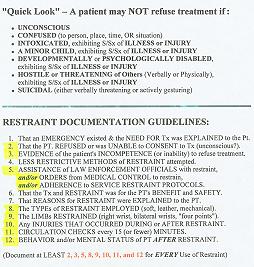


This page is STILL under CONSTRUCTION!
Until this "blurb" is REMOVED, this page remains a "rough draft" version, and its contents should NOT NECESSARILY be implemented as currently written. However! Protocol-writers with a strong understanding of the information contained within the articles, "All Tied Up & No Place To Go" and "Restraint Asphyxia – Silent Killer," should be able to use this "ROUGH" information to build their own protocol. If you have "time" to delay your protocol writing, PLZ check back here periodically, to see if MY version of this protocol has been completed!
 The following text was "PLUGGED IN HERE" from, "All Tied Up & No Place To Go"
The following text was "PLUGGED IN HERE" from, "All Tied Up & No Place To Go"

DOCUMENTATION OF RESTRAINTS:
Improper or inadequate documentation of restraint will damn you in a court of law. If what you "recall" about patient-care delivery and management (actions that occurred many months – even years – before) does not fully correspond with what you documented, your credibility is discounted.(9)
When you have restrained a patient, you "SHOULD" document all of the following:
Certainly, not every restraint situation requires such extensive documentation. I routinely document only those points numbered 2, 3, 5, 8, 9, 10, 11, and 12. However, we are all familiar with the litigious nature of today's society. Whenever you have restrained someone who strikes you as having a litigious nature, or when the bystanders or family members strike you as having a litigious nature, the more of these points that you document, the more protected you will be by your documentation.
 |
reference card similar to this one, so you have a handy on-scene or post-scene restraint reference, GO TO THE QUICK LOOK CARD PAGE! |

AH. NOW, I see that I'd also been working on this (The Stuff Below), BEFORE! I don't have time right now to see if the stuff below DIFFERS from the stuff above.
What part of "A Work In Progress" aren't you picking up on?! LOL!

RESTRAINT DOCUMENTATION GUIDELINES:
Document at LEAST 2, 3, 5, 8, 9, 10, 11, and 12
for EVERY Use of Restraint!

APPROPRIATE, SAFE & EFFECTIVE, RESTRAINT PROTOCOLS:
and Basic Principles Regarding, SAFE Patient Restraint
is Employed Prior To Your Arrival
Violently Confused or Combative Trauma Patient


 Email Charly at: c-d-miller@neb.rr.com
Email Charly at: c-d-miller@neb.rr.com